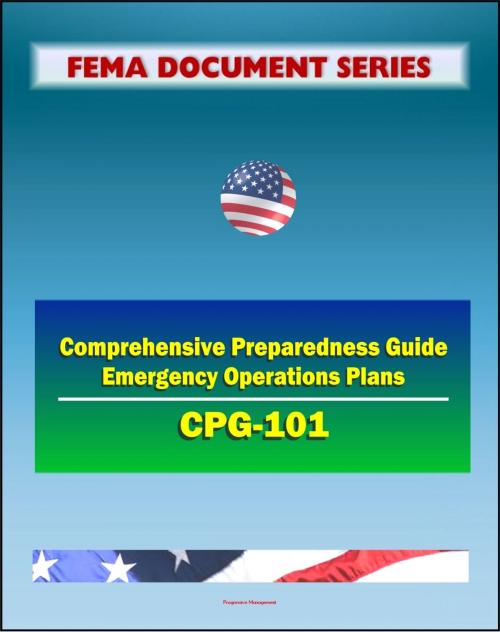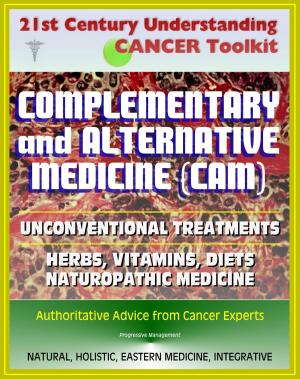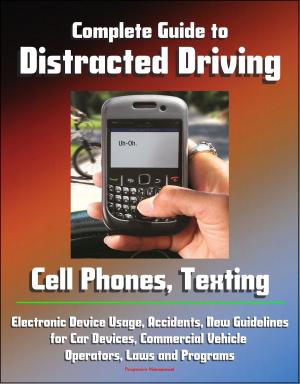21st Century FEMA Document Series: Comprehensive Preparedness Guide (CPG) 101 - Developing and Maintaining Emergency Operations Plans, Version 2.0 - November 2010
Nonfiction, Social & Cultural Studies, Political Science| Author: | Progressive Management | ISBN: | 9781466011427 |
| Publisher: | Progressive Management | Publication: | July 21, 2011 |
| Imprint: | Smashwords Edition | Language: | English |
| Author: | Progressive Management |
| ISBN: | 9781466011427 |
| Publisher: | Progressive Management |
| Publication: | July 21, 2011 |
| Imprint: | Smashwords Edition |
| Language: | English |
This Federal Emergency Management Agency (FEMA) document, Comprehensive Preparedness Guide (CPG) 101, provides guidance for developing emergency operations plans. It promotes a common understanding of the fundamentals of risk-informed planning and decision making to help planners examine a hazard or threat and produce integrated, coordinated, and synchronized plans. The goal of CPG 101 is to assist in making the planning process routine across all phases of emergency management and for all homeland security mission areas. This Guide helps planners at all levels of government in their efforts to develop and maintain viable, all-hazards, all-threats emergency plans. Based on input from state, territorial, tribal, and local officials from across the United States, this update of CPG 101 expands on the fundamentals contained in the first version. With this edition, greater emphasis is placed on representing and engaging the whole community — to include those with access and functional needs, children, and those with household pets and service animals. Residents and all sectors of the community have a critical role and shared responsibility to take appropriate actions to protect themselves, their families and organizations, and their properties. Planning that engages and includes the whole community serves as the focal point for building a collaborative and resilient community. CPG 101 is the foundation for state, territorial, tribal, and local emergency planning in the United States. Planners in other disciplines, organizations, and the private sector, as well as other levels of government, may find this Guide useful in the development of their emergency operations plans. While CPG 101 maintains its link to previous guidance, it also reflects the reality of the current operational planning environment. This Guide integrates key concepts from national preparedness policies and doctrines, as well as lessons learned from disasters, major incidents, national assessments, and grant programs.
Comprehensive Preparedness Guide (CPG) 101 provides Federal Emergency Management Agency (FEMA) guidance on the fundamentals of planning and developing emergency operations plans (EOP). CPG 101 shows that EOPs are connected to planning efforts in the areas of prevention, protection, response, recovery, and mitigation. Version 2.0 of this Guide expands on these fundamentals and encourages emergency and homeland security managers to engage the whole community in addressing all risks that might impact their jurisdictions.
While CPG 101 maintains its link to previous guidance, it also reflects the reality of the current operational planning environment. This Guide integrates key concepts from national preparedness policies and doctrines, as well as lessons learned from disasters, major incidents, national assessments, and grant programs. CPG 101 provides methods for planners to:
* Conduct community-based planning that engages the whole community by using a planning process that represents the actual population in the community and involves community leaders and the private sector in the planning process
* Ensure plans are developed through an analysis of risk
* Identify operational assumptions and resource demands
* Prioritize plans and planning efforts to support their seamless transition from development to execution for any threat or hazard
* Integrate and synchronize efforts across all levels of government.
This is a privately authored news service and educational publication of Progressive Management.
This Federal Emergency Management Agency (FEMA) document, Comprehensive Preparedness Guide (CPG) 101, provides guidance for developing emergency operations plans. It promotes a common understanding of the fundamentals of risk-informed planning and decision making to help planners examine a hazard or threat and produce integrated, coordinated, and synchronized plans. The goal of CPG 101 is to assist in making the planning process routine across all phases of emergency management and for all homeland security mission areas. This Guide helps planners at all levels of government in their efforts to develop and maintain viable, all-hazards, all-threats emergency plans. Based on input from state, territorial, tribal, and local officials from across the United States, this update of CPG 101 expands on the fundamentals contained in the first version. With this edition, greater emphasis is placed on representing and engaging the whole community — to include those with access and functional needs, children, and those with household pets and service animals. Residents and all sectors of the community have a critical role and shared responsibility to take appropriate actions to protect themselves, their families and organizations, and their properties. Planning that engages and includes the whole community serves as the focal point for building a collaborative and resilient community. CPG 101 is the foundation for state, territorial, tribal, and local emergency planning in the United States. Planners in other disciplines, organizations, and the private sector, as well as other levels of government, may find this Guide useful in the development of their emergency operations plans. While CPG 101 maintains its link to previous guidance, it also reflects the reality of the current operational planning environment. This Guide integrates key concepts from national preparedness policies and doctrines, as well as lessons learned from disasters, major incidents, national assessments, and grant programs.
Comprehensive Preparedness Guide (CPG) 101 provides Federal Emergency Management Agency (FEMA) guidance on the fundamentals of planning and developing emergency operations plans (EOP). CPG 101 shows that EOPs are connected to planning efforts in the areas of prevention, protection, response, recovery, and mitigation. Version 2.0 of this Guide expands on these fundamentals and encourages emergency and homeland security managers to engage the whole community in addressing all risks that might impact their jurisdictions.
While CPG 101 maintains its link to previous guidance, it also reflects the reality of the current operational planning environment. This Guide integrates key concepts from national preparedness policies and doctrines, as well as lessons learned from disasters, major incidents, national assessments, and grant programs. CPG 101 provides methods for planners to:
* Conduct community-based planning that engages the whole community by using a planning process that represents the actual population in the community and involves community leaders and the private sector in the planning process
* Ensure plans are developed through an analysis of risk
* Identify operational assumptions and resource demands
* Prioritize plans and planning efforts to support their seamless transition from development to execution for any threat or hazard
* Integrate and synchronize efforts across all levels of government.
This is a privately authored news service and educational publication of Progressive Management.















